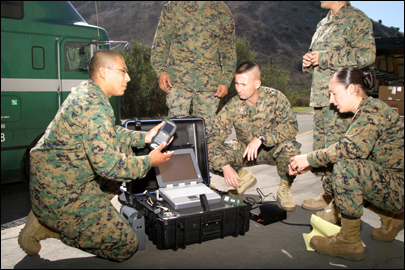Supply chain technology company Savi Technology says it has developed a mobile kit containing all the hardware and software needed to enable military personnel deployed in remote locations to read tags on incoming supplies, and to send orders for replenishments.
Savi says the U.S. Marine Corps has already placed a multimillion-dollar order for 100 of the units, called Portable Deployment Kits (PDKs), and plans to deploy them throughout its military theaters in Iraq and Afghanistan.
The kits contain a Panasonic CF50 laptop, an Iridium modem and a SatCom antenna to enable communication to the U.S. Department of Defense’s In-Transit Visibility (ITV) network via satellite, a GPS receiver (integrated with the modem), an antenna for the GPS unit, two Savi SMR 650 mobile RFID readers and a Symbol PDT 8146 wireless bar code scanner. This hardware is stored in a large, ruggedized case that complies with military “single-person lift” weight requirements, which stipulate that a single person can carry the unit and it does not require in-flight cargo storage. According to David Stephens, Savi’s senior vice president, public sector, this means personnel can access the PDK immediately upon arrival at a remote outpost.
A second version of the kit comes with a Zebra Technologies mobile printer that fits in the case and can be used to print a bar code onto a shipping label, but not to encode an embedded RFID tag. While the kit is designed for use with active RFID tags, the Savi mobile readers can be configured to read and encode EPC passive tags.
All of the components inside the PDK are powered through a central hub that sits in the PDK case and plugs into a vehicle’s 12-volt electrical system. The components’ power and communication cords link into this hub. Personnel, says Stephens, simply “plug into a DC outlet in their Humvee, put the Iridium satellite antenna on the roof, turn the kit on and set up a choke point to read tags on incoming goods.”
Savi’s Site Manager software comes preinstalled on the laptop. The software filters and aggregates tag reads from the two mobile SMR 650 readers. When one of the SMR 650 devices is joined to the Symbol 8146, it can read RFID tags, as well 1-D and 2-D bar codes used on some military shipping labels. As personnel use the handheld in the field, it stores tag and bar code data. This data is periodically uploaded to the laptop, either through a wireless link enabled by a Wi-Fi card or through a serial cable connection. The other SMR also sends data to the laptop through a serial connection, and can be mounted to create a choke point to read tags on goods coming into an area.
Savi says the kit was designed to allow military logisticians to link into the ITV network and use the mobile readers to locate, order and transport goods, from ammunition to uniforms, throughout their area of operation.
Stephens says Savi is currently in discussions with a number of end user companies about potential commercial applications for the PDK. “The kit could be useful at remote sites for oil exploration,” he explains. “It could be used to set up a remote logistics management or asset-tracking site anywhere, as long as there is outdoor access for satellite communication.” Or, instead of having an Iridium modem, the PDK could be fitted with a GRPS modem to send data over a GSM network. If located within range of a wireless local area network, he says, the laptop could link into it instead of using a satellite or GPRS connection.


